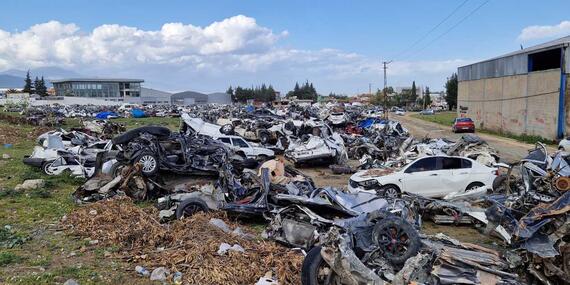Türkiye: Free transport service offers respite for quake survivors

Text and photos by Alimbek Tashtankulov
Ali drives his Hatay municipality bus slowly in the earthquake-ravaged Serinyolu Mahallesi neighbourhood in Antakya, in southern Turkey, looking out for passengers. He runs the bus like a dolmuş — a private minibus seen in many Turkish cities that lets passengers choose where to disembark.
“Some people are not aware of our free bus service yet, so I need to be proactive and gesture to them if they need a ride,” he explained.
While passing by the Mustafa Kemal University Research Hospital, Ali stops at the campus entrance gate and asks a security guard: “Can you please tell people coming here that there is a free bus service coming here every two hours? Thank you!”
Some passengers who board the bus ask Ali about the fare. Smiling, he replies: “The bus service is free from our Hatay municipality. Please tell other people.”
The two major earthquakes that struck several Turkish provinces in February killed about 50,000 people (including 22,500 people in Hatay Province), according to the Turkish Government. Thousands of houses collapsed or were severely damaged, and an estimated 1.1 million people now live in tents or containers in camps near their damaged houses or informal sites. Most public services, including public transport, were disrupted by the devastating damage and destruction.
Fatih Bilgin, a Disaster Response Coordinator from Istanbul Metropolitan Municipality, now supports Hatay Municipality. He explains there are now three bus lines in Hatay that provide free transport service for earthquake survivors living in temporary shelters in camps for displaced people in the city and its surroundings.
The shuttles transport about 85 passengers every day, but that number will gradually increase as more people become aware of the service, and as more routes are added and the coverage area expands.
From challenge to opportunity
Ali Gokpinar, OCHA Team Leader in Hatay, in Antakya, said: “We realized after the quake that people who survived the earthquake lost their cars, and they have been unable to get to hospitals, pharmacies and shops, or simply go around to meet their relatives and family.”
“We brought this idea of free bus shuttles to the Istanbul Metropolitan municipality, and it supported the local municipality to kickstart this service, which runs between larger tent/container camps and hospitals and key public service points.”
The humanitarian bus shuttles are an example of turning a challenge into an opportunity to provide a service to people affected by the unprecedented disasters. Passengers are responding positively: “It is very good to be able to get where we need to, especially since there is no other transport,” said one passenger, adding that he received an SMS about the service. “I am sure there will be many more people on these buses once more people know about them.”
The International Organization for Migration reported that the earthquakes displaced about 3 million people in Türkiye. More than 2.4 million people currently live in temporary settlements, 1.6 million of whom are residing in informal settlements, while almost 792,000 are in formal sites.
The most severely affected areas include Adıyaman, Hatay, Kahramanmaraş and Malatya; they currently host 92 per cent of the population living in temporary settlements. Hatay has the highest number of people living in formal sites and informal settlements.
The UN launched a US$1 billion Flash Appeal to assist 5.2 million affected people. As of 10 April, the appeal is only 28.2 per cent funded ($283.7 million).
